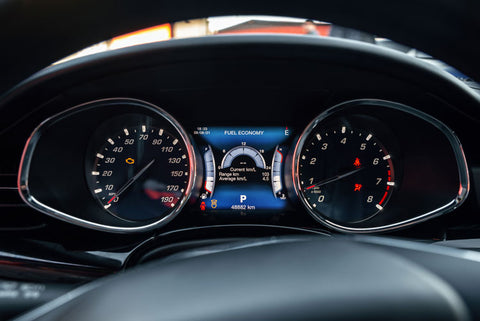What Are the Symptoms of a Bad ECM?

A car’s engine control module (ECM) is arguably one of its most essential parts. From ignition timing and idle speed to air-fuel mixture and fuel pressure, modern vehicles can’t do much without an ECM.
In this blog post, BenchForce, a leader in automotive bench programming components, explains what an ECM is, describes how it operates, and highlights what symptoms to look for when there may be a problem.
What is an ECM?
The engine control module (ECM), also referred to as the engine control unit (ECU), is the engine’s computer that controls engine performance. It also collects information from the other sensors in your vehicle and monitors the fuel-to-air ratio and engine timing.
When mechanics or car enthusiasts reprogram an engine, the engine control module is “tuned” or “remapped” as it controls the engine’s performance and vehicle’s drivability. People also call ECMs:
- Engine control system (ECS)
- Powertrain control module (PCM)
- Vehicle control module (VCM)
Sidenote: Before ECMs, many of a car’s mechanisms were controlled mechanically and pneumatically. In the 1970s, ECMs started becoming a standard device in vehicles. Today, automotive manufacturers pack your car with electronic components.
To find vehicle performance issues, many mechanics and car enthusiasts use an onboard diagnostic (OBD) scanner. The scanner collects information and regulates your vehicle’s performance to alert you of any problems. An OBD system consists of an ECM as well as (a/n):
- Actuators: convert energy to permit physical movement (e.g., ignition coils, throttle blades, cam phasers, EGR valve)
- Sensors: send system codes to the ECU, indicating the source and issue (e.g., O2 sensor, temperature sensors, pressure sensors)
- Diagnostic Trouble Code (DTC): a combination of letters and numbers that identify a specific issue
- Malfunction Indicator Lights (MIL): warning lights that appear for vehicle malfunctions (flashing lights indicate an urgent problem, while lasting lights are considered minor)
- Diagnostic Link Connector (DLC): data and codes for vehicles with OBD systems
However, you don’t necessarily need an OBD scanner to know that there’s a problem. There are other (and more obvious) signs of a bad ECM, such as:
1. Check Engine Light (Or Other Sensors)

The “check engine” light on your vehicle’s dashboard typically appears when the vehicle’s computer detects an issue with one or more sensors. You (or a mechanic) can scan the computer for trouble codes that indicate a specific problem with the vehicle, which will determine if the engine light is on due to ECM failure or another complication.
The most common trouble codes with the check engine light are:
- Codes: P0171 through P0175 (sensing your oxygen levels)
- Codes: P0300 through P0305 (engine misfires)
- Codes: P0411, P0440, P0442, P0446, and P0455 (evaporative system)
- Code: P0401 (exhaust gas recirculation)
- Codes: P0420 and P0430 (catalytic converter)
- Code: P0335 (malfunction in the crankshaft position circuit)
- Codes P0342; P0343 (Camshaft Position Sensor "A" Circuit Low; High)
- Code: P0327 (Knock Sensor 1 Circuit Low)
For more check engine trouble codes, visit OBD-Codes.
2. Engine Performance Issues
If your engine is misfiring, stalling, or experiencing other performance issues, it may be a sign of a faulty engine control module. Given that the ECM is responsible for making adjustments to your engine, your vehicle may experience drastic changes in fuel efficiency, power, and acceleration. What’s more, these issues do not have to be consistent; the sensor’s light may turn on and off with or without a pattern.
3. Poor Fuel Efficiency
A faulty ECM will prevent your engine from regulating how much fuel to burn during fuel consumption. As a result, your vehicle will typically require you to spend more money on gas due to its excessive fuel consumption. Functioning ECMs will result in lower costs and optimized fuel consumption.
4. Car Won’t Start
If there is a problem with your vehicle’s ECM, the car may be challenging to start or may not turn over at all. An ECM may also cause an engine to shut off without warning, most likely due to an inaccurate fuel-to-air ratio. However, ECMs are often not the sole cause of complications with starting your vehicle.
5. Transmission Complications
A faulty ECM can send poor data to your vehicle’s transmission control module (TCM). As a result, the vehicle cannot properly shift gears or apply power, causing the shift to feel awkward, delayed, or even jarring. When this occurs, the engine may sporadically become more active or stall out. If you have issues with your transmission, check your vehicle’s dashboard for any lights or run ECM diagnostics.
Sources of ECU Issues

The issue with your ECU may be easier to identify than you think. In fact, it may not even be the ECU that’s causing the problem. Some of the most common issues are caused by:
- Corrosion on the Terminals
- Bad Connectors
- Shoddy Wiring
Transmission Complications
A faulty ECM can send poor data to your vehicle’s transmission control module (TCM). As a result, the vehicle cannot properly shift gears or apply power, causing the shift to feel awkward, delayed, or even jarring. When this occurs, the engine may sporadically become more active or stall out. If you have issues with your transmission, check your vehicle’s dashboard for any lights or run ECM diagnostics.
Harness Connections
Your ECM OR TCM might be throwing a code, but it’s not the module itself causing an issue. You could have corrosion on the terminals, causing a bad connection. The signals from the sensors wired into those circuits aren’t getting to the ECU, and now it thinks your air/fuel ratio is wrong or your O2 sensor isn’t working correctly.
Most ECUs are mounted in the engine bay, exposing the module and its connectors, terminals, and wires to extreme fluctuations in temperature. These fluctuations and road conditions with sand, mud, dirt, oils, and salt can wreak havoc on your systems.
Hit The Ground(s) Running
A faulty ECU may be reported at your OBD-II connector, but in actuality, you have a ground wiring issue. Like the harness connections, the grounds are typically wired to the chassis itself, exposing those to all the same harsh conditions that the ECU connections are subjected to. Having a bad ground is usually easy to suss out; just keep “ringing out” the wires until you find the one that isn’t grounded. The hard ones to diagnose are intermittent issues, like while you’re rolling down the road and the ground is bouncing, not always making a good connection. You may need to clean and reattach all the ECU and TCM grounds, then retest.
Making the Most of Your Vehicle
There are many symptoms of ECM failure. Whether your car won’t start or you’d like its performance to be optimized, BenchForce sells the parts you need to make the most out of your vehicle. If you’d like to learn more about our products and services, visit our online store, FAQ, or contact us today!
